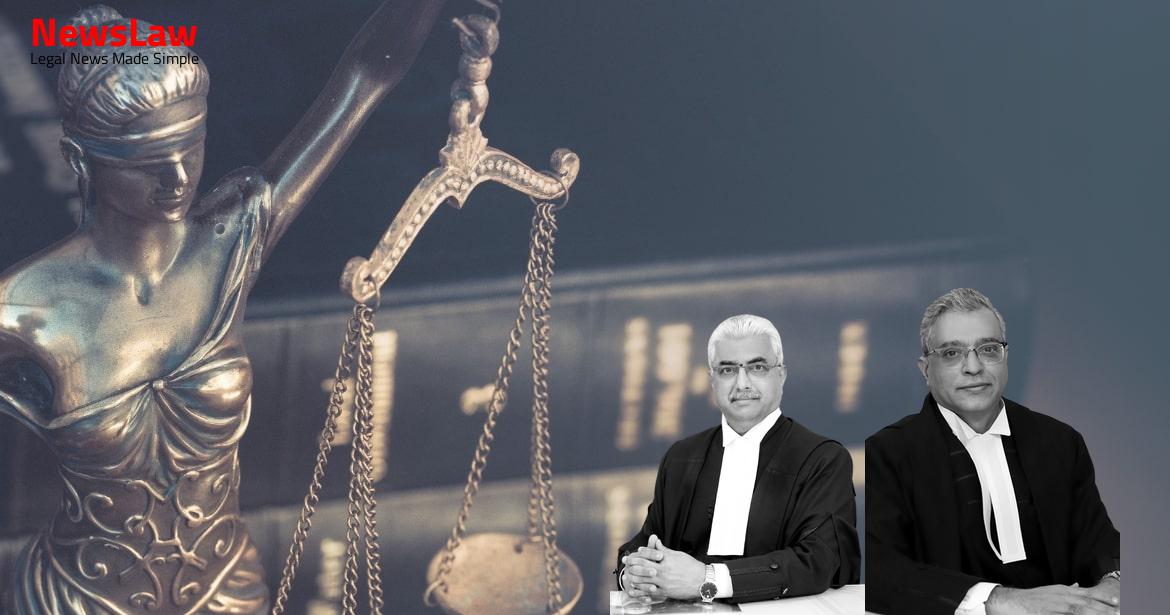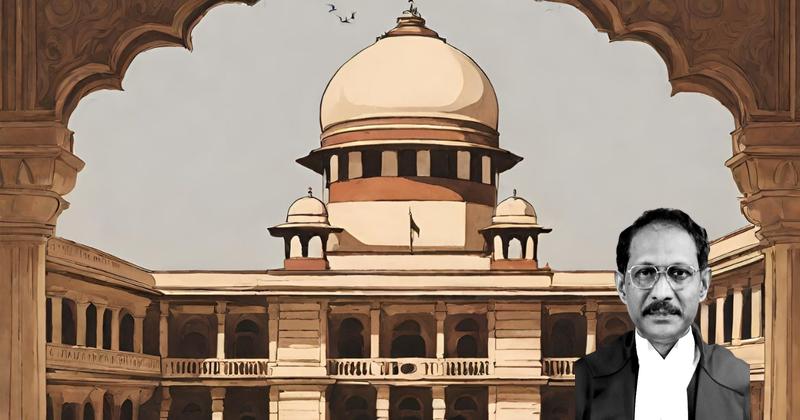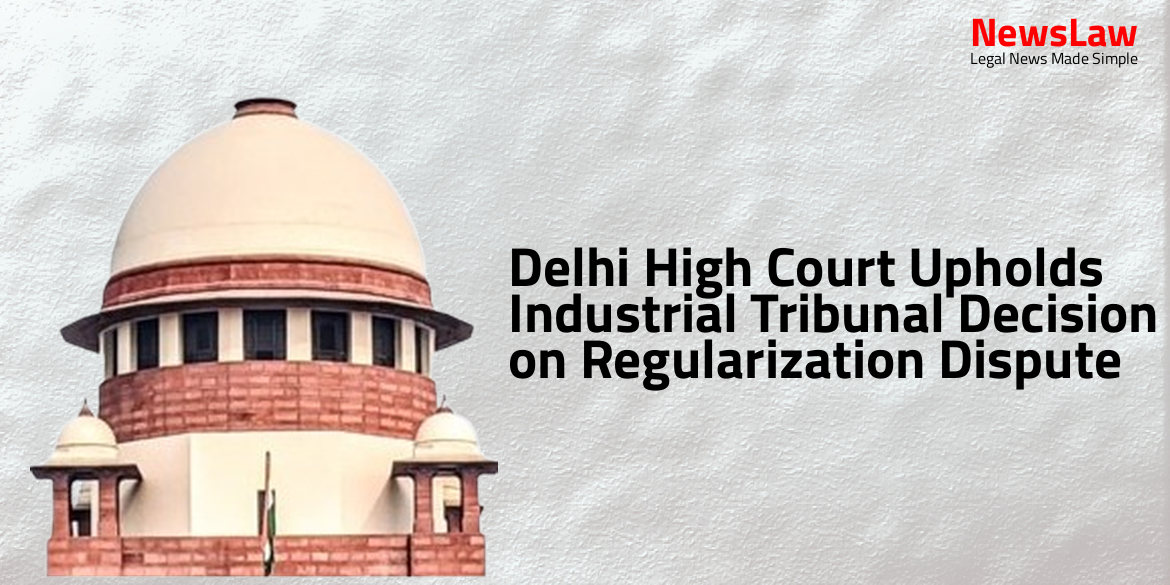The case of Industrial Dispute involving the management and the workmen saw a crucial verdict by the Industrial Tribunal, where the rights of the workers were upheld. The dispute, which centered around the regularization and backwages of the workmen, led to a detailed examination of the nature of work and employment status. Stay tuned to discover the key details of this significant legal battle.
Facts
- Settlement stating they do not deserve does not seem genuine to discard cases of 13 persons.
- Evidence of Witness No. 2 examined on behalf of the 1st Party Management is crucial.
- Tribunal found that the 13 workmen are not eligible for regularization.
- Central Government referred the whole dispute to Industrial Tribunal as settlement was for only 19 workmen.
- Tribunal rejected the preliminary objection regarding jurisdiction under Contract Labour (Regulation and Abolition Act) and considered nature of work by 13 workmen.
- Clause 11.5.0 of N.C.W.A. IV states contract laborers cannot be engaged for permanent and perennial jobs.
- Tribunal’s judgment dated 23.05.2002 directed regularization of the remaining 13 workmen.
- Witness confirmed that 13 persons were also working in permanent and perennial nature of job.
- Workmen examined 3 witnesses, management examined 4 witnesses before Tribunal.
- Agreed to regularize 19 persons as General Mazdoor, Category-I, in NCWA-V Pay Scale.
- Contention that other persons are engaged in casual jobs not prohibited under Contract Labour (R&A) Act.
- Witness No. 3 of 1st Party Management stated work of railway siding is regular and perennial for which 19 persons were regularized.
- All 32 persons were involved in removing spillages for railway Biding and operating chutes in the bunker.
- The appellant filed a Writ Petition challenging the Tribunal’s judgment regarding regularization of 13 workers.
- Tribunal found 19 workers were performing perennial work while the remaining 13 had casual work.
- Section 25F of the Industrial Disputes Act does not apply as workers were under a contractor, not the appellant.
- The High Court upheld the Tribunal’s decision as the work of the 13 workers was considered casual.
- The nature of work performed by all 32 workers was removing spillages and operating chutes.
- The settlement was based on the verification of the nature of the work performed by the workers.
Also Read: Jurisdiction and Legal Analysis in Contractual Matters
Arguments
- The settlement between the parties was binding and continues to be so as it was never terminated.
- Rule 58 of the Industrial Dispute (Central) Rules, 1957 does not pose a legal obstruction to the remedy sought by the workers.
- Workers seeking regularization and backwages must show they are not currently employed.
- Evidence presented by the workers indicates that 13 workers actively participated in tasks considered regular and perennial.
- Grant of backwages cannot be automatic or a natural consequence of regularization.
- The Tribunal incorrectly directed the appellant to disburse backwages to the 13 workers.
- The work in the railway siding was argued to be perennial and regular similar to works in the bunker.
- Claim of regularization of similarly placed workers was not resolved, giving them the right to pursue remedy under the Industrial Disputes Act, 1947.
- The workmen suffered through no fault of their own.
- The order of regularization should lead to the grant of consequential backwages.
Also Read: Legal Analysis in Civil Appeal Case
Analysis
- The Tribunal was justified in giving its award on the reference made by the central government.
- The settlement itself addresses the claims of 32 workers raised by the respondent-union.
- The Tribunal found that all 32 workers had similar work history and should have been considered for regularization.
- The settlement provided for regularization of 19 out of the 32 workers, prompting the reference to the Tribunal to adjudicate on the interest of all 32.
- The Tribunal was within its jurisdiction to examine the entire reference and provide independent findings.
- The artificial distinction made by the appellant between the regularized and non-regularized workers was not found convincing.
- The Tribunal’s findings on the nature of work performed by the workers were deemed solid and unchallengeable.
- Various key personnel were examined in the process, leading to the final settlement in 1997.
- The settlement agreement was invoked by the government to refer the matter to the Tribunal for consideration of all 32 workers.
- The evidence supported the Tribunal’s decision that all workers, regularized or not, had similar work status and should have been considered for regularization.
- No grounds found in the artificial distinction asserted by the appellant
- Case was argued at length but reasons provided for rejecting the appeals
- Findings of fact by the Tribunal as affirmed by the High Court cited
- Concurrent findings of fact on the nature of work, continuous working, and nature of employment
- No merit found in the appeals filed by the appellant due to the aforementioned findings
- Case involves wrongful denial of employment and regularization for workmen with no fault on their part
- No order restricting the wages of the workmen
Also Read: Ensuring Procedural Integrity in Environmental Safeguarding
Decision
- Workmen entitled to backwages as observed by the Industrial Tribunal.
- Backwages to be calculated from the decision of the Tribunal dated 23.05.2002.
- Modification in the order of the Tribunal confined to backwages calculation.
- Public interest and lengthy litigation considered in the decision.
- Appeals arising from the High Court judgment and order dismissed.
- Concerned workmen entitled to backwages from 23.05.2002.
- No costs ordered.
Case Title: MAHANADI COALFIELDS LTD. Vs. BRAJRAJNAGAR COAL MINES WORKERS UNION (2024 INSC 199)
Case Number: C.A. No.-004092-004093 / 2024



